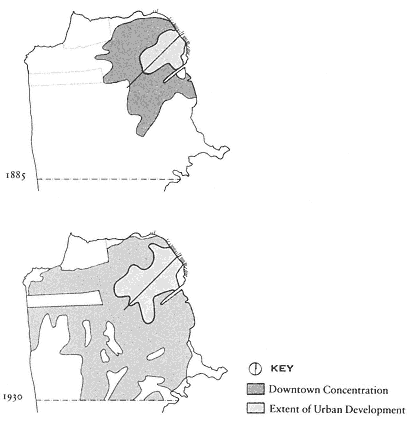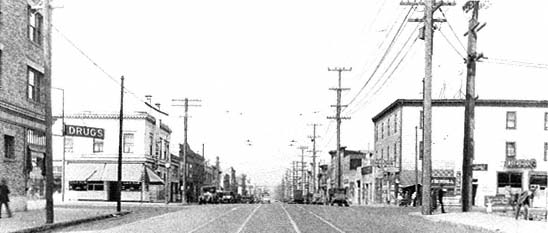Public Impressions and Residential Opposition
Within San Francisco's development and specialization, George Smith and Edward Rolkin lived and worked in widely separated spheres. Smith, through his success in elegant downtown hotels, became a lead-
ing booster of the city. He was vice president of the Golden Gate International Exposition, a director of the Chamber of Commerce, president of the Downtown Association, and treasurer of the San Francisco Convention and Visitors Bureau. He retired in 1961 at seventy-two years of age and sold his share of the Mark Hopkins for a reputed $10 million.[51] As true urbanites, after retirement he and his wife moved to a fashionable downtown apartment near Union Square. Rolkin, an immigrant, never fully retired and personally managed his string of hobo hotels until he died in 1941 at the age of ninety, a social outsider with a real estate fortune of $2 million. He had served on the California State Board of Equalization, but his most important social or civic organization seems to have been the Independent Order of Oddfellows. Rolkin's obituary dubbed him the "Landlord of Skid Row."[52] Although both Smith and Rolkin trained themselves, built large hotels, and personally managed them, they remained in the two separate worlds of residential hotel life: on the one hand, the culturally acceptable; on the other, the merely necessary.
Most middle and upper class citizens came to perceive the negative, necessary side of hotel life far more clearly than its positive, more culturally acceptable side. The specialization of hotel buildings and districts as well as the lives of their residents helped to exacerbate the negative public perceptions. In the 1880s, downtown housing and the mixtures of the old city comprised a large share of San Francisco's extent. In addition to the downtown core, a third or more of the residential neighborhoods still had occasional commercial single-room housing and retail uses. In those large areas, such mixture was a part of everyday urban experience (fig. 6.16). By 1930, the city's number of hotel rooms had quadrupled; the ratio of hotel rooms per person in the city was substantially higher than in the 1880s. The concentration of hotel life in the downtown core had expanded significantly. However, outlying neighborhoods with an occasional residential hotel represented only a tenth of San Francisco's extent. The new city of more single-purpose areas—areas for only residence or only production—stretched for miles. Thus, by 1930 one of the most salient features of downtown housing had become its dramatic contrast with the outlying residential districts. Together, the expensive and cheap downtown residence zones comprised an island of urban life very different from that in the rest of the city.[53] People outside the suburban family model or

Figure 6.16
Comparison of the extent of old city mixture in San Francisco, 1885 and 1930.
As the city grew after 1900, dense mixtures of housing and commercial
activities became a much smaller proportion of the city's total area.
who chose family life in an old city mode were increasingly concentrated downtown.
The gradual architectural specialization of the city from 1880 to 1930 helped to make positive hotel life less visible to people of the middle and upper class (as was the case with George Babbitt) while it made negative hotel life more visible. As always, well-dressed middle-income hotel dwellers melted into the downtown crowd.[54] Meanwhile, for well-to-do citizens the people who symbolized social and personal failure became more vividly associated with hotel homes. While a relatively small percentage of successful people were known to live in hotels, a very high proportion of hoboes, poor single clerks, drunks, and prostitutes were known as hotel residents. From the carriage, streetcar, or automobile one was far more likely to remember a bum who had passed out in front of a cheap lodging house than the happy thirty-year-old clerk walking to his rooming house. Among single-family house dwellers, the best-known aspects of the cheap hotel zones became their culturally questionable recreational pursuits. In zones of converted houses, the ROOMS TO RENT signs and the rooming houses
they represented came to be seen as the cause of urban blight rather than the side effects of underlying migration, layoffs, real estate speculation, or expansion of the business district.
The new permanence of the downtown housing districts was even more significant than their specialization. As downtown landowners like Rolkin and the various Pacific Heights professionals built their larger buildings on more prominent street corners, they announced that the alternative hotel life-styles were not a passing phase. The downtown housing areas were not, as one Chicago sociologist had labeled them, a "zone in transition." The owners of the new brick, steel, and concrete residential hotel buildings had clearly built for at least sixty years—the same life expectancy of the adjacent office and loft buildings. The permanent residential interiors of the new hotel buildings signaled the potential for a long-term zone of opposition to the cultural ideals behind the new city. In 1917, the California state senator, Lester Burnett, used dire predictions of persistence to exhort his colleagues to pass a stronger housing act. Where "only apartment houses, hotels, and lodging houses are built," he said, referring to San Francisco, "the city blocks are becoming a mass of buildings of steel and brick so solidly constructed as to last a century or more ."[55] At the time of the San Francisco fire, Senator Burnett might have seen the city's ad hoc wooden hotels as temporary necessities, a passing urban phase. Like the shanty city required for the workers who built the gleaming new capital of Brasilia, San Francisco's minimal hotels had seemed a necessity for the building and rebuilding of the new city. When the city was finished, Burnett and others felt that the cheap lodgings would collapse like packing crates and that their denizens would go away or somehow move to new single-use suburbs. However, when the workers' housing became permanent—"as to last a century or more," as Burnett put it—observers became alarmed (fig. 6.17).
The specialization of downtown buildings also fueled the separation between the culturally acceptable and merely necessary hotel realm, as shown in the careers of George Smith and Edward Rolkin. Smith knew the polite hotel's need for skilled managers. At the end of his life he generously endowed San Francisco's professional hotel and restaurant school, which was named after him. Rolkin left a substantial sum to an agricultural school in Poland but gave nothing to train managers of cheap lodging houses; academically trained managers were not part of

Figure 6.17
Temporary versus permanent structures in San Francisco's South of Market district.
The simple wooden rooming house (right ) contrasts with the brick housing
structure (left foreground ) at Folsom and Ninth streets, 1927.
the concept of running low-caste hotels. New clerks got only on-the-job training, as is still the case today. The distinct social relations of Smith's and Rolkin's hotel worlds meant that Smith enjoyed fraternal relationships with his customers, while Rolkin had paternalistic relationships with his. Smith, an avid golfer, advised Mark Hopkins guests on the local courses; Rolkin left a sixth of his estate to purchase candy, tobacco, and other treats for the residents of the county relief home, many of whom would have been his former tenants. The hundreds of absentee hotel landlords in San Francisco had even less direct relationships with their clients than Rolkin. However, they did leave distinct regions of the city that they had collectively built.
Rolkin knew that he was operating marginally reputable businesses—at least in the view of middle and upper class culture, yet he died during World War II with his hotels at absolute peak capacity. To that same polite culture, Smith seemed beyond reproach. Oddly, Smith lived to see the unraveling of the residential life that he had built into the Canterbury, Mark Hopkins, and Fairmont hotels. He also saw one of America's first giant urban renewal projects of the 1950s raze most of Rolkin's properties and guarantee the value of his own. The work of both Rolkin and Smith came to be attacked for threatening the cultural and social life of San Francisco. As both of these men built, leased, and traded hotels they had also unconsciously been generating opposition to their investments. They were "current capitalists" willing to "try the experiment of a civilization without homes." At stake were more than profits or architecture. The grander cultural critique had to do with
how "home" was to be defined in the United States, in how many different ways, and by whom.
By 1970, a generation after Smith and Rolkin's time, many of the downtown real estate assumptions that seemed so permanent in the 1920s had evaporated. People had stopped building outlying hotel experiments by the time of the Great Depression. The confident Nob Hill/Gold Coast/Upper Fifth Avenue projections for elegant residential hotels also were unrealized. By 1970, the current capitalists of America, in Calhoun's terms, seemed suddenly not interested in the experiment of a civilization without homes. The broad cultural critiques of hotel life, seemingly ignored by the owners and managers of hotels, were to play a major role in that change.